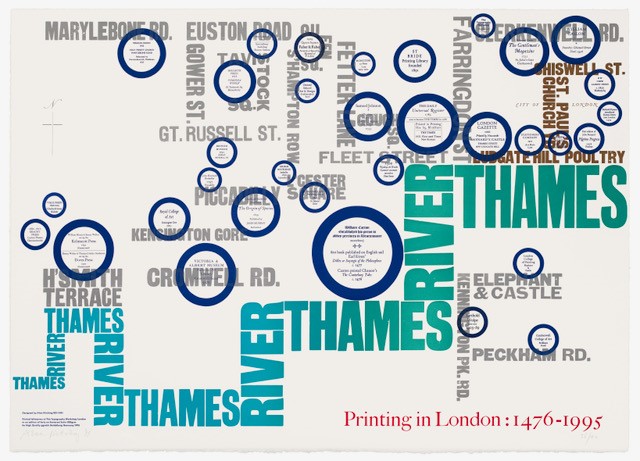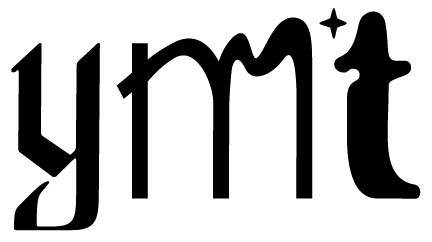On the irrelevance of letterpress
What does today's practice of letterpress contribute to modern typography? What is the purpose of holding letterpress alive and what is the future of letterpress?
This article is about the exploration of letterpress in the context of modern typography. Talking to the letterpress artist Alan Kitching, and with our own experiments, we tried to start a discussion about the relevance and contribution of letterpress to modern typography. As becoming designers, typographers and digital natives this discussion seems rather essential: Are there any relevance to the craft and art, in which our primarily digital instruments have their origins? Can modern technology substitute traditional craft?
Alan Kitching, born 1940, is one of the world’s leading practitioners of letterpress typographic design and printmaking. He has spent almost his entire life making characteristic colorful prints from hard wood and metal letterforms. Alan is bringing an old craft to life in the modern world working with, amongst others, The National Theatre, The Guardian and The Royal Mail. Alan is a Honorary Fellow of the Royal College of Art and a visiting professor at the University of the Arts London, still to this day, at the age of 81. He has workshops and lectures about letterpress and typography around the globe.
To approximate possible solutions to our questions we interviewed Alan Kitching:
A: Hello Mr Alan Kitching. How does the place and time one was born, the way one was brought up, influence or shape their work as a designer?
B: I was born in 1940 in Darlington in the North East of England where there was a long tradition of mining and railworks and most people worked in these industries. However his grand- father was a sign writer, and I inherited some of his creative spirit, so instead of working in the local industry, I was apprenticed to the local printer and learned the art of compositing (typesetting).
What is the purpose of keeping letterpress alive and what ́s the future of letterpress?
I am not interested in preserving letterpress in a static, purely functionary form. My interest lies in using the wooden and metal type blocks and the traditional presses as the medium in which I express my creativity. Heritage crafts such as letterpress have their own value. They require dedication and skill to achieve the finest results as opposed to the automation associated with computers. For some time I was almost the only person keeping letterpress alive, but in recent years I have been pleased to see more people wanting to learn and use these traditional printing met- hods and experiment with letterpress.
How do you manage to create new ideas and expressions working with the same letters and colors repeatedly?
Each commission or piece of my work has a different raison d’être. New ideas are inspired by the text that I use; the things that I am reading; the joy of words and language. My raw ma- terial is language and words. I put different emphasis on those words by the selection of the colours which reflect the tone of the phrasing and add to their visual expression.
Do you consider yourself to be a part of a specific type or letterpress tradition?
I started in the normal typographic way – using black and white printing in a Bauhaus tra- dition. But I have been kicking against this for the past quarter of a century to deliberately break the conventions and tradition with my experimentation. You could say that I am an iconoclast, but I can only do what I do successfully because I have an in-depth experience and knowledge of the letterpress.
What is your favourite font?
In my opinion the best lettering alphabet was designed by Edward Johnston for the London Underground signage in 1916. And is still in use today. And the best type is Caslon Old Face designed and cut by William Caslon c.1734. And Gill Sans designed by Eric Gill in 1938.





By Alan Kitching
In our own practical work in the letterpress workshop of our school we experienced the contrasts between two design processes. We learned that, based on which tools you use to create typography (in that case letterpress vs. Glyphs and Adobe programs), things change entirely: The idea process, the timespan between thought and execution, the outcome itself, your relation to the work and your (physical) involvement in the design process.
We approach our resources in both technological and analogue crafts differently because of our technological and computerized context. Still, when we as typographers try to integrate the particular design process of letterpress within our skills in technological typography, we can experience the improvement and enrichment in both method and outcome that occurs when two design processes are re-joined.
After this intense period of research and experiment we have to acknowledge that some things still remain unresolved: How can we really measure the relevance of letterpress? What are the limits of traditional crafts and of this discussion? Is letterpress design, art or craft?
We both came to the conclusion that these questions can only be solved through keeping on interacting with the craft, working with it, questioning it and taking it beyond and further. Throughout our research we got inspired to explore the traditional crafts that are the roots of the design craft now. The example of Alan Kitching showed us how we can make letterpress relevant in our time. It was an inspiration and food for thought to discuss the relevance of letterpress and traditional crafts today. What would we lose if this craft dies?
Resources
- Alan Kitching, Alan Kitching’s A-Z of Letterpress: Founts from The Typography Workshop, Laurence King Publishing, 2017.
- Karoline Newman: Alan Kitching, FX, London, 2018.
- The A-Z of Alan Kitching‘s London, Advanced Graphics London, 2019.
- Faust Dikko, Letterpress tessellation, Journal of mathematics and the arts, 2020-04-02, Vol.14 (1-2).
- The new typography workshop
- Handy Book of Artistic Printing : A Collection of Letterpress Examples.
Further Resources
- Assosiaction for the Black Art
- Letterpress tessellation Faust, Dikko, Journal of mathematics and the arts, 2020-04-02, Vol.14 (1-2), p.46-48
- Demo & Discourse: Dan Wood on Letterpress Printing
- Ladies of letterpress
- Mike O‘Brien, AIGA DC Editor & Digital Content Chair, Power of print for public discourse, October 9, 2020
- Design Week at 30: Alan Kitching on life in letterpress, 2017
- Alan Kitching: Man of Letters, English Heritage, 13.03.2020
- Material: Making and the Art of Transformation, Chelsea Green Publishing, 29.09.2020
- The history of letterpress printing, Elation Press, Houston




